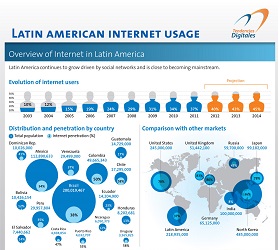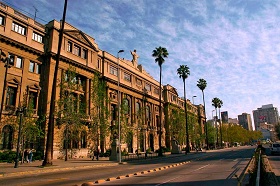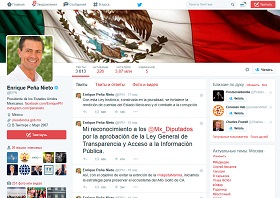With the arrival of 21st century, the Internet has become a key factor in global development, although Latin America and the Caribbean (LAC) is often seen as one of the poorest and socially insecure regions, largely bypassed by global technological trends. However, LAC has is playing a dynamic role in the virtual space, as university-based advanced technologies are significantly changing public consciousness, reformatting the information space and providing a platform for innovative political trends.
University as the Launch Pad for Latin American Internet
The Latin American virtual space was pioneered by Mexico, which was fast on the heels of its northern neighbors. While the United States and Canada launched their first local networks in July 1988, at the turn of the 1990s several major Mexican universities invested financially and intellectually into the National Science Foundation Network (NSF or NSFNET), which was somewhat similar to Russia’s FidoNet. This system became the infrastructure base and launch pad for the regional Internet, when on February 28, 1989 the Monterey Institute of Technology launched the NSFNET, albeit only on an inter-university scale [1]. The event was followed by similar experiments by National Autonomous University of Mexico - UNAM, the country's leading higher educational institution. In 1992, the system was used as the platform for the expansive MexNet, an information network uniting 12 educational organizations including five key universities. The university's potent presence in the implementation of advanced technologies must be the reason why .edu.mx remains the most popular domain for Mexicans in their country and beyond.
Mexico's neighbors wasted no time in taking up the initiative, with the key promoters of the future Internet being private universities in all countries except Chile, where in April 1990 NSF technology was employed by the University of Santiago to develop and advance the NIC-Chile local network. In Central America private University del Valle de Guatemala and National University of Engineering in Nicaragua introduced its versions of NSF in 1992 and 1994, respectively. The private University of Los Andes, the Colombian trailblazer, registered the .co domain in 1991 and launched its own network in 1994. Venezuela initiated its Academic Network of National Science Centers and Universities in 1992. The exclusions in this university marathon were Argentina in 1990, where the appropriate network was sponsored by the Ministry of Foreign Affairs and Foreign Trade, and Brazil, where the NSF network was launched by government-sponsored Comité Gestor de Internet en Brasil.
Digital Portrait of the Latin American Internet Segment
According to the statistics, mid-2020s Latin America is certainly a region with a dynamically developing virtual space. LAC opened the new millennium as the fourth-largest Internet user (and is still in this position) with 18 million clients. North American corporation comScore, which specializes in Internet technologies and digital marketing, in its report 2014 LATAM Digital Future in Focus says that in June 2014 LAC could boast 176 million online users, only slightly ahead of Africa and the Middle East (170 million). The Pacific, Europe and the United Sates are far ahead with 776, 424 and 222 users respectively. Nevertheless, Latin America is a dynamically developing Internet space, where percentage growth on 2013 was 17 percent (27 percent in Africa and the Middle East, 19 percent in Asia-Pacific). This increment in Europe and the United States was a meager two percent. Most of the users live in Brazil (70.9 million), followed by Mexico (25.4 million), Argentina (18.5 million), Colombia (13.3 million), Venezuela (9.9 million), Chile (6.4 million) and Peru (5.9 million). At the same time, the number of users seems to be a floating indicator that varies from source to source. For example, according to the Infolatam agency, back in 2013 the figure was 255 million. In any case, everyone expects the Internet space will expand exponentially, i.e. 60 percent of the Latin American population with a stable network connection and about 120 million more users.
LAC comes third after Europe and the United States in terms of average Internet time per user per month, i.e. 21.1 hours against 25.1 and 32.6 hours respectively. The Latin American figure is closest to the global average of 22.8 hours. Due to their advanced Internet infrastructure, Uruguay and Brazil have become regional leaders in Internet time and exceed the European level, with respectively 32.6 and 29.4 hours per user monthly. Interestingly, Mexico differs in its pattern for portable computer use. Whereas in other countries these are the main device for Internet connection, in Mexico cell phones are much more popular than in other LAC countries, i.e. 9.4 percent against 4.4 percent in Brazil, 5.5 percent in Argentina and 8.2 percent in Chile. Analysts forecast more mobile Internet in future, since 85 percent of South Americans and 84 percent of Central Americans possessed cell phones in 2014.
At the same time, there are issues in the Latin American Internet - despite what one might think from the statistics. Along with extensive visual growth, the virtual space is low in intensity parameters. LAC Internet operates much more slowly than in the industrialized world. According to a survey by Spanish company Llorente&Cuenca set out in its report The Present and Future of the Internet in Latin America, the average data transfer speed for the region is 3 MBps, whereas the OECD average is 20 MBps and South Korea, the global leader, peaks at 100 MBps. In LAC, the top link speed is in Uruguay (15.5 Mbit), followed by Chile, Brazil and Mexico (8 Mbit on the average), Ecuador (5.8 Mbit) and Argentina (4.6 Mbit) . The lowest speed of 1.9 Mbit is seen in Bolivia and Venezuela. Another key factor is high Internet price. Information services rates seem to have been on a steady downward curve since 2010, but remain much higher than in Europe and the United States. Even the countries where it is cheapest, i.e. Panama and Uruguay at USD 10 per month, are double the European tariffs (USD 4.5 in Spain and USD 2.0 in France).
One source of potential for Latin American Internet growth lies in its greater youthfulness compared with other regions, with 60 percent of users in the 15-34 age group, while the world's average is 53 percent. Alongside steady engagement in the virtual space, young people are susceptible to emerging technologies and are keen on proselytizing. Curiously, the relatively low development level seems to trigger the Internet’s dynamic advance in Latin America but while Internet coverage in OECD countries averages at 80 percent of the population, the LAC figure is hardly 40 percent.
Transnational technology corporations are investing heavily in LAC virtual space, as in early 2014 Microsoft promised to invest USD 10 million in the regional digital literacy. One of the most prominent region-wide Internet development programs is the FRIDA (Fondo Regional para la Innovación Digital en América Latina y el Caribe) with its USD 1.5 million budget, about 50 private and international participants and 15 regional states. FRIDA vows to advance the LAC information society, but it was set up only in 2013, so it remains too early to assess its efficiency.
Virtual Reality in Action: From Economy to Language
One can hardly underestimate the Internet’s impact on the socio-economic and cultural fabric of Latin America, as the world wide web is vigorously reformatting the regional economy. Just take the fast-growing electronic trade. According to a VISA survey, in 2011 remittances totaled USD 43.2 billion, despite Internet apathy and even illiteracy among Latin American businesses. DonWeb founder Guillermo Tornatore supports this view, noting that 66 percent of Latin American firms have no websites and do nothing to advance their products through the Internet, with most economic traffic generated by transnational groups eager to win regional markets.
The world wide web is also changing the Latino public consciousness. In the 2014 Global Confidence Barometer presented at the Davos World Economic Forum, 70 percent of respondents said they prefer digital sources to traditional print materials, while 62 percent trust the hybrid news that come to the Internet from the print media. Since the mid-2010s, we have seen a qualitative rise in those who trust social media and websites as compared to those who prefer the traditional press, radio and television, echoing the global expansion of new technologies in the worldwide information space.
The Internet is also changing existing marketing strategies. The US Media Consulting 2014 Report on Latin American Media Market shows that 80 percent of consumers search the Internet before making a purchase, with the share of people buying vehicles that check online first in Brazil standing at 95 percent and in Colombia at 90 percent.
The three most credible social media platforms are Facebook, Google and YouTube, with the Facebook being the outright leader. It is sufficient to say that Brazil is the globally second largest country with registered Facebook accounts. Latin Americans are far ahead of European and U.S. residents in the time they spend on social media, i.e. 10.3 hours per month against 7.1 and 5.5 hours respectively.
LAC appears to take the lead globally in presidential blogging, which has gained enormous social and political significance. Political journalism widely employs the terms cyber-politics and politics 2.0, with the LAC barely lagging behind other regions. Most state leaders run their own accounts in popular social media, the pioneering role belonging to the late Hugo Chavez of Venezuela, who was the first Latin American leader to gather one million Twitter subscribers. The current champion is Mexican President Henrique Pena Nieto (blog @EPN) with 4.2 million subscribers on Facebook and 3.9 million on Twitter. The top four also includes the Presidents of Argentina (@CFKArgentina), Colombia (@JuanManSantos) and Brazil (@DilmaBR).
Interestingly, Latin Americans seem to perceive the global web in their own creative manner. While most of the world describes the Internet aficionados by the English word user, the Spanish language has developed neologism elinternauto that comes from astronaut, highlighting the travelling side of the web activities.
Governmental Internet in Latin America
State-run websites and portals in Latin America are quite popular and, according to comScore, are regularly visited by about one third of users (61.2 million), with the obvious lead taken by Brazil (34.7 million), which is far ahead of Mexico (7 million), Argentina (5.6 million) and Venezuela (4.4 million). Many regimes are keen on advancing electronic government with some clear successes. In 2014, the UN biennial electronic government rating showed Uruguay in the top trio for civil society participation after Holland and South Korea. The top ten also lists Chile, which came eighth. At the same time, a much more important technology criterion – the Electronic Government Index – gives the 26th position to Uruguay, which is trailed by Chile (33rd), Argentina (46th), Colombia (50th), Brazil (57th) and Mexico (63rd). The Uruguayan electronic government system provides for the online processing 70 percent of documents and applications, while the authorities plan to reach 100 percent in two years.
The Latin American experience of regional cooperation in the electronic servicing area also seems quite beneficial. In 2003, the Network of e-Government Leaders of Latin America and the Caribbean or GEALC was set up under OAS auspices with funding from the Inter-American Development Bank. The system is mainly used for research, coordination and consulting, but also for sharing practices and promoting innovative solutions within the e-government framework. Electronic interaction between the government and society in Latin America is really high on the agenda, as can be seen from the 1st Forum of Digital Strategies of Ibero-America, whose final declaration underlined that the sides were ready "to strengthen regional cooperation in the electronic government technologies as a tool for social and economic development".
***
Latin America is currently moving toward becoming a full-fledged information society, and faces the challenges common to any transition. On the one hand, the virtual space is advancing dynamically and there is a steady rise in the numbers of users, while on the other, its infrastructural component is undeniably poor. To this end, Latin America seems to present a risky but also promising proving ground for high-tech investment. Its Internet future is obviously bright, although external actors may be set to reap the reward if self-development is not given top priority.








